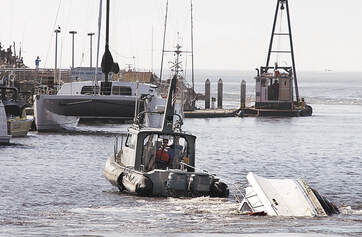 Harbor Patrol Boat towing a capsized boat after the 2011 tsunami - photo by Dan Coyro
Harbor Patrol Boat towing a capsized boat after the 2011 tsunami - photo by Dan Coyro If, like me, you're not a boater, you probably think the Santa Cruz Harbor Patrol is only purposed with maintaining order in the harbor and helping boaters in distress in and near the harbor itself. You may have seen Dan Coyro's picture at left of the Harbor Patrol boat towing a capsized boat after the 2011 tsunami that wreaked havoc on our small harbor. Although I spend a huge amount of time in the ocean, I have to admit, I certainly never gave the Harbor Patrol much thought.
But then, as I started working on my next novel, currently titled The Swimmer (you can check out the beginning in my Work in Progress section), I knew I needed to do some research on ocean rescues. My scenario is very dramatic and I thought the chances of my swimmer being rescued were nil but I needed to describe an attempted rescue in the book.
I met briefly with one of the members of the Santa Cruz Fire Department's Marine Rescue Unit, thinking these were the people who would attempt such a rescue. Over the years, I'd seen them doing physically demanding training exercises at night along West Cliff Drive.
I was hoping to understand how they'd attempt a rescue of a swimmer trying to commit suicide in Monterey Bay at night, expecting lots of information about their jet skis, search patterns, rescue swimmers, etc. And while they have all that, apparently, if we're looking at a rescue more than a couple hundred yards offshore, especially at night, it would be the Harbor Patrol that would pursue the rescue, possibly in coordination with the Coast Guard. I was told that the Harbor Patrol boat had all sorts of cool high tech equipment including thermal imaging, side sonar, sophisticated radar and more, and that I should contact the Harbormaster to find out how they approached ocean rescues.
I spoke with Latisha Marshall, the Harbormaster, and she gave my contact information to Blake Anderson, the assistant Harbormaster. Blake would meet with me to explain rescue strategies and show me their rescue boat.
I sent Blake a link to my scenario and when I arrived, he greeted me and introduced me to Latisha. Blake was more than prepared to answer my questions. I laid out my scenario and apologized, saying I understood that the likelihood of saving my swimmer was just about zero. But Blake interrupted me and said he wasn't so sure. Over the next thirty minutes he told me about some remarkable rescues. One was led by Don Kinneman (Senior Deputy Harbormaster) and was later recounted by Santa Cruz's resident ocean science guru, Gary Griggs. Griggs writes a not-to-be-missed biweekly column for the Santa Cruz Sentinel titled Our Ocean Backyard.
Griggs describes ocean disasters, impacts of climate change, pollution, and much more. You can find archives of his articles here.
In the early 70s, Griggs did a study of ocean currents in Monterey Bay. He dropped floats containing postcards at various points along the coast and followed where they were found. Ironically, in the summer of 1972, I found one of the floats in the rocks on the south end of Four-Mile Beach. Grigg's current research would play a significant role the first story.
Amazing Rescues
In one of the rescues, Don Kinneman led the search for two brothers whose Hobie Cat had capsized. Two very distressed women had entered the Harbor office just before dark. The first was the wife of one brother and the second was the fiance of the other brother. The brothers were supposed to have returned hours before. Don put together a crew and following the lead of the Coast Guard, searched southeast of the last known position (accounting for drift from the northwest winds). But after hours of searching they were forced to return to the harbor about midnight.
Frustrated with their lack of success, Don didn't give up. Having studied Gary Griggs' results on currents in the Monterey Bay, he pulled out charts, and plotted where the currents might have taken the brothers. Don, and Cary Smith, another Harbor Patrol Officer, went back out and after starting a sweep search in the projected area, found one brother clinging to the side of the overturned boat 10 miles offshore. He was hypothermic and likely near death so they raced back to shore and then returned to search for the other brother. A mile further out, on a pitch-black night, they rescued the other brother. If you think about the vastness of the Monterey Bay and the odds of finding a swimmer 11 miles out, this is truly miraculous - or beyond miracles, perhaps Don Kinneman is a rescue force to be reckoned with!
Gary Griggs gives us a nice footnote to the story that Blake didn't relate. Don, and Cary were invited to the brother's wedding a few weeks later. For his first toast, the groom raised his glass to Don and Cary without whose help, the wedding would have never happened.
As Blake finished this story, which clearly reset my expectations about my swimmer's rescue, Laticia jumped in. "Why don't you tell Steve about that rescue where you were awarded the Rescue Professional Hero Award?" she suggested.
Modest Blake reluctantly agreed to tell the story.
He was on duty one evening and heard what seemed to be static on the radio. The operator had concluded that it was just static. Somehow, Blake thought he heard something else. At first it was 'mile buoy' and then 'water'. Since no one else heard this, Blake went on instinct. He found a crew member and they motored out to the mile buoy - just in case his hunch was right. Not far beyond the buoy, they found an overturned Hobie Cat. They continued their sweeping search and located the victim another quarter mile away. Once again, this was another successful rescue in what I thought of as a near impossible situation.
The Harbor Patrol Boat
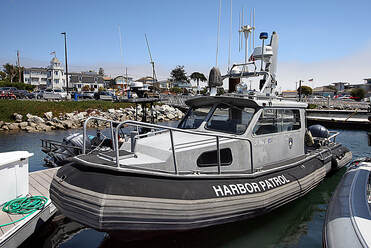 The current 21-year-old Harbor Patrol Boat - photo by Dan Coyro
The current 21-year-old Harbor Patrol Boat - photo by Dan Coyro Today, the Harbor Patrol Rescue Boat is a 21-year-old 28' RIB (Rigid Inflatable Boat) with twin 250 HP Yamaha outboards. The 'cabin' is tricked out with two displays which show charts, side-sonar imaging (looking at the bottom up to 40' down), thermal imaging, radar images, and much more. They have a camera where they can record interactions with boats or rescues. The boat has a top speed of almost 50 knots (nearly 58 mph), so it can get to distress situations remarkably fast. The soft sides make it easier to come alongside other boats and to bring victims on board.
The Harbormaster staff includes 4 deputies who are 'offshore certified'. As Latisha and Blake explained to me, this is a rigorous training and certification program where part of the final exam is done in the boat at night with blacked-out windows. The candidate must show navigation and rescue skills using only instruments.
I put on a PFD and Blake led us slowly out of the Harbor. One screen showed the thermal imaging while the other used the side-sonar to show the bottom of the harbor entrance. We headed toward the wharf, my eyes jumping back and forth between the thermal imaging and the windows. A few hundred yards into our trip, I saw a kelp bed ahead of us, just offshore from the Boardwalk. It looked like any other kelp bed. But on the thermal image, I spotted 6 white balls moving around. As we got closer, I could see that this was a family of sea otters - well hidden in the kelp, but visible through thermal imaging.
On our way out to the mile buoy, we passed some swimming sea lions. Again, I would never have seen them visually but the thermal imaging clearly saw their heads as they periodically rose above the water.
Several hundred yards from the buoy, I could see the buoy on the thermal imaging screen. I was a bit surprised, but Blake explained that the system spotted temperature differences and the buoy was warmer than the ocean. Several large white objects were moving on the buoy - sea lions. I realized just how powerful this imaging tool was. And apparently, the Coast Guard boats and helicopters are similarly equipped.
On our way back to the harbor, Blake talked about other work he and the Harbor Patrol had undertaken. Over the last few years, they've become instrumental in cliff rescues. As most of us know, not only do people fall off cliffs into the ocean or get knocked off by unexpected waves, far too many beach walkers fail to pay attention to the tides. Incoming tides have trapped many on virtually inaccessible cliff faces and in caves.
While it's the Fire Department's cliff rescue and marine rescue teams that usually perform the actual rescues themselves, they need to locate the victims first. With high cliffs or high wave conditions, this can be nearly impossible. But once again, it's the Harbor Patrol and their thermal imaging to the rescue. They can locate people and help guide the rescue teams to the victims.
Blake also talked about the Harbor Patrol's recent involvement with law enforcement. I won't go into detail here, but they now do training for police departments, SWAT teams, and Federal agencies.
As you can see, I was impressed. Between 2015 and 2018, the Harbor Patrol saved over 217 lives. I never suspected that the Harbor Patrol was so critical to the safety of our ocean-loving community. And I wondered why. Why didn't I know this? How is it I could have underestimated their contribution? I hope that this blog and my accounts to surfing buddies and friends will help get the Harbor Patrol more recognition.
The good news is that the Harbor Master recently received a Federal grant that will allow them to replace the aging Harbor Patrol Boat with a new $550,000 craft so that they can be even more effective.
If you see the Harbor Patrol while surfing, boating, kayaking, stand-up paddling, or during other ocean activities, give them a wave. And if there's an issue on the ballot that involves funding for the Harbormaster or Harbor Patrol, give it due consideration. This team might one day save your life or the life of someone you love.
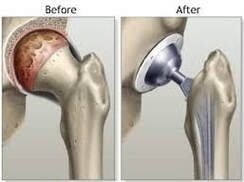
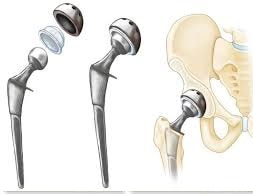
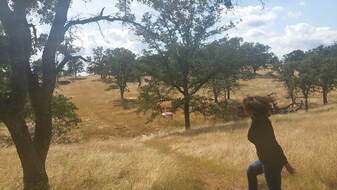
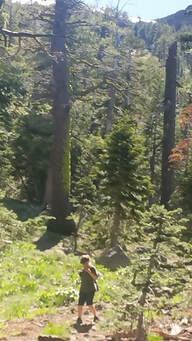

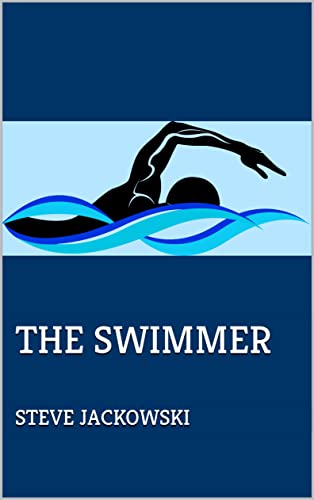
 RSS Feed
RSS Feed